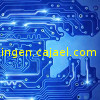[adsense:responsibe:9545213979]
Catalogo de semiconductores bipolares: Diodos y Tiristores de Infineon (Ingles)
Solapas principales
[adsense:336x280:9156825571]
1. Introduction 6 1.1 Diode 6 1.2 Thyristor 7 2. Type and polarity designation 9 2.1 Designation of the terminals 9 2.2 Constructions 9 2.2.1 General 9 2.2.2 Disc cells 9 2.2.3 PowerBLOCK-Module 9 2.2.4 Stud type and flat case constructions 10 3. Electrical properties 11 3.1 Forward direction 11 3.1.1 Forward off-state current iD 12 3.1.2 Forward off-state voltage vD 12 3.1.2.1 Repetitive peak forward off-state voltage VDRM 12 3.1.2.2 Non-repetitive peak forward off-state voltage VDSM 13 3.1.2.3 Forward direct off-state voltage VD (DC) 13 3.1.3 Forward breakover voltage V(BO) 13 3.1.4 Open gate forward breakover voltage V(BO)0 13 3.1.5 Holding current IH 13 3.1.6 Latching current IL 13 3.1.7 On-state current iT, ITAV, ITRMS iF , IFAV, IFRMS 13 3.1.8 On-state voltage vT, vF 14 3.1.9 On-state characteristic 14 3.1.10 Equivalent line approximation with VT(TO), VF(TO) and rT 14 3.1.11 Maximum average on-state current ITAVM, IFAVM 15 3.1.12 Maximum RMS on-state current ITRMSM, IFRMSM 15 3.1.13 Overload on-state current IT(OV), IF(OV) 15 3.1.14 Maximum overload on-state current IT(OV)M, IF(OV)M 15 3.1.15 Surge on-state current ITSM, IFSM 17 3.1.16 Maximum rated value â«i²dt 17 3.2 Reverse direction 18 3.2.1 Reverse current iR 18 3.2.2 Reverse voltage vR 18 3.2.2.1 Repetitive peak reverse voltage VRRM 18 3.2.2.2 Non-repetitive peak reverse voltage VRSM 18 3.2.2.3 Direct reverse voltage VR(DC) 18 3.3 Control properties of thyristors 19 3.3.1 Positive gate control 19 3.3.1.1 Gate current iG 19 3.3.1.2 Gate voltage VG 19 3.3.1.3 Gate trigger current IGT 19 Contents 23.3.1.4 Gate trigger voltage VGT 19 3.3.1.5 Gate non-trigger current IGD 19 3.3.1.6 Gate non-trigger voltage VGD 19 3.3.1.7 Control characteristic 20 3.3.1.8 Control circuit 20 3.3.1.9 Minimum duration of the trigger pulse tgmin 23 3.3.1.10 Maximum permissible peak trigger current 23 3.4 Carrier storage effect and switching characteristics 24 3.4.1 Turn-on 24 3.4.1.1 Diode 24 3.4.1.1.1 Peak value of the forward recovery voltage VFRM 25 3.4.1.1.2 On-state recovery time tfr 25 3.4.1.2 Thyristor 25 3.4.1.2.1 Gate controlled delay time tgd 26 3.4.1.2.2 Critical rate of rise of the on-state current (di/dt)cr 26 3.4.1.2.3 Repetitive turn-on current IT(RC)M 27 3.4.1.2.4 Critical rate of rise of off-state voltage (dv/dt)cr 27 3.4.2 Turn-off 27 3.4.2.1 Recovery charge Qr 27 3.4.2.2 Peak reverse recovery current IRM 29 3.4.2.3 Reverse recovery time trr 30 3.4.2.4 Turn-off time tq 30 3.5 Power dissipation (losses) 33 3.5.1 Total power dissipation Ptot 33 3.5.2 Off-state losses PD, PR 33 3.5.3 On-state losses PT, PF 33 3.5.4 Switching losses PTT, PFT+PRQ 34 3.5.4.1 Turn-on losses PTT, PFT 34 3.5.4.2 Turn-off losses PRQ 35 3.5.5 Gate dissipation PG 35 3.6 Insulation test voltage VISOL 35 4. Thermal properties 36 4.1 Temperatures 36 4.1.1 Junction temperature Tvj, Tvj max 36 4.1.2 Case temperature TC 36 4.1.3 Heatsink temperature TH 37 4.1.4 Cooling medium temperature TA 37 4.1.5 Junction operating temperature range Tcop 37 4.1.6 Storage temperature range Tstg 37 4.2 Thermal resistances 37 4.2.1 Internal thermal resistance RthJC 37 4.2.2 Thermal transfer resistance RthCH 37 4.2.3 Heatsink thermal resistance RthCA 38 4.2.4 Total thermal resistance RthJA 38 4.2.5 Transient internal thermal resistance ZthJC 38 4.2.6 Transient heatsink thermal resistance ZthCA 38 4.2.7 Total transient thermal resistance ZthJA 39 34.3 Cooling 39 4.3.1 Natural air cooling 39 4.3.2 Forced air cooling 39 4.3.3 Water cooling 39 4.3.4 Oil cooling 39 5. 5. Mechanical properties 40 5.1 Tightening torque 40 5.2 Clamping force 40 5.3 Creepage distance 40 5.4 Humidity classification 40 5.5 Vibration 40 5.6 UL-registration 40 6. Notes for applications 41 6.1 Case non-rupture current 41 6.2 Thermal load cycling 41 6.3 Parallel connection 42 6.4 Series connection 44 6.5 Pulsed Power 46 6.5.1 Applications with DC 46 6.5.2 Current rise time at turn-on 46 6.5.3 Zero crossing of current and voltage during turn-on 47 6.5.4 Turn-off with a high di/dt versus a negative voltage 47 7. Protection 49 7.1 Overvoltage protection 49 7.1.1 Individual snubbering (RC-snubber) 49 7.1.2 Input snubbering for AC-controllers 52 7.1.3 Supply snubbers for line commutated converters 53 7.1.4 Additional options for protection versus energy intensive overvoltages 55 7.2 Overcurrent protection 56 7.2.1 Short-term protection with superfast semiconductor fuses 56 7.2.1.1 Selection of fuses 56 7.2.2 Further protection concepts: short-term protection of high power semiconductors 59 7.2.2.1 High speed DC-circuit breakers 59 7.2.2.2 Crowbar (electronic short circuit) 59 7.2.2.3 Line side circuit breaker 59 7.2.2.4 Blocking of trigger pulses 59 7.2.3 Long-term protection 59 7.2.4 Fully rated protection 59 7.3 Dynamic current limiting with inductors in the load circuit 60 7.4 Reduction of interference pulses in the gate circuit 61 48. Mounting 62 8.1 Disc cases 62 8.1.1 Mounting of disc cells 62 8.1.2 Positioning the heatsinks 66 8.1.3 Connection of busbars 66 8.1.4 Connection of the control leads 67 8.2 Stud cases 67 8.2.1 Mounting stud cases 67 8.2.2 Positioning the heatsinks 67 8.2.3 Connection of busbars 68 8.2.4 Connection of the control leads 68 8.3 Flat base cases 68 8.3.1 Mounting flat base devices 68 8.3.2 Positioning the heatsinks 69 8.3.3 Connection of busbars 69 8.3.4 Connection of the control leads 69 8.4 PowerBLOCK-Modules 69 8.4.1 Mounting PowerBLOCK-modules 69 8.4.2 Positioning the heatsinks 69 8.4.3 Connection of busbars 70 8.4.4 Connection of the control leads 70 9. Maintenance 70 10. Storage 70 11. Type designation 71 12. Circuit topologies 72 A1. Abbreviations 74 A2. List of Figures 76 A3. List of tables 78 A4. Conditions of use 79
Español



Añadir nuevo comentario